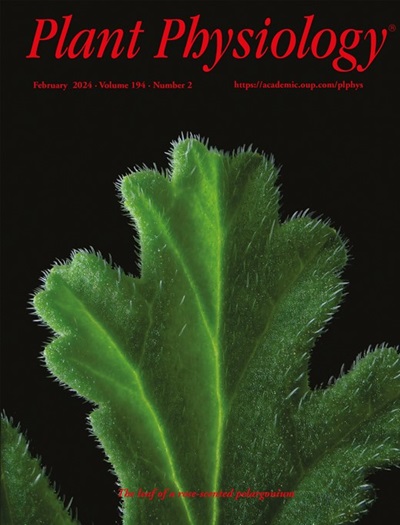转录调节因子VAL1通过抑制器官边界基因BOP1和BOP2促进拟南芥开花
IF 6.5
1区 生物学
Q1 PLANT SCIENCES
引用次数: 0
摘要
向生殖发育的过渡是植物生命周期的关键步骤,依赖于内在和环境信号的整合。控制开花时间的几个不同途径在感知环境线索的下游发挥作用,如白天长度(光周期途径)和季节温度(春化和环境温度途径)。此外,植物激素赤霉素(GA)在非诱导光周期下诱导花的转变。在模式植物拟南芥(Arabidopsis thaliana)中,转录抑制因子VIVIPAROUS1/ABI3-LIKE1 (VAL1)在春化过程中触发花抑制因子开花位点C (FLC)的稳定抑制。然而,VAL1在其他开花途径中的作用尚不清楚。在这项工作中,我们结合遗传学和转录组学方法研究了不同日照长度下VAL1对开花激活的需求。我们发现,无论是长日照还是短日照,诱导花转化都需要VAL1,而不是它的姊妹蛋白VAL2。外源GA完全绕过了val1突变体植株的延迟开花时间。我们证明了val1介导的开花诱导部分是通过器官边界基因BLADE-ON-PETIOLE1 (BOP1)和BOP2的直接表观遗传抑制发生的。因此,我们的工作扩大了VAL靶基因的库,并进一步证明了VAL因子在调节拟南芥发育中的多效性作用。本文章由计算机程序翻译,如有差异,请以英文原文为准。
The transcriptional regulator VAL1 promotes Arabidopsis flowering by repressing the organ boundary genes BOP1 and BOP2
The transition to reproductive development is a critical step in the plant lifecycle and relies on the integration of intrinsic and environmental signals. Several different pathways controlling flowering time function downstream of the perception of environmental cues such as day length (photoperiodic pathway) and seasonal temperature (vernalization and ambient temperature pathways). In addition, the phytohormone gibberellin (GA) induces the floral transition under non-inductive photoperiod. In the model plant Arabidopsis (Arabidopsis thaliana), the transcriptional repressor VIVIPAROUS1/ABI3-LIKE1 (VAL1) triggers the stable repression of the floral repressor FLOWERING LOCUS C (FLC) during vernalization. However, the involvement of VAL1 in other flowering pathways remains unclear. In this work, we combined genetic and transcriptomic approaches to investigate the requirement of VAL1 for flowering activation under different day lengths. We found that VAL1, but not its sister protein VAL2, is required to induce the floral transition both under long and short days. The delayed flowering time of val1 mutant plants was fully bypassed by exogenous GA application. We demonstrated that VAL1-mediated induction of flowering occurs partially via the direct epigenetic repression of the organ boundary genes BLADE-ON-PETIOLE1 (BOP1) and BOP2. Our work thus expands the repertoire of VAL target genes and further demonstrates the pleiotropic role of VAL factors in regulating Arabidopsis development.
求助全文
通过发布文献求助,成功后即可免费获取论文全文。
去求助
来源期刊

Plant Physiology
生物-植物科学
CiteScore
12.20
自引率
5.40%
发文量
535
审稿时长
2.3 months
期刊介绍:
Plant Physiology® is a distinguished and highly respected journal with a rich history dating back to its establishment in 1926. It stands as a leading international publication in the field of plant biology, covering a comprehensive range of topics from the molecular and structural aspects of plant life to systems biology and ecophysiology. Recognized as the most highly cited journal in plant sciences, Plant Physiology® is a testament to its commitment to excellence and the dissemination of groundbreaking research.
As the official publication of the American Society of Plant Biologists, Plant Physiology® upholds rigorous peer-review standards, ensuring that the scientific community receives the highest quality research. The journal releases 12 issues annually, providing a steady stream of new findings and insights to its readership.
 求助内容:
求助内容: 应助结果提醒方式:
应助结果提醒方式:


